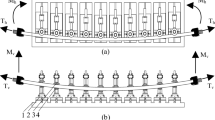Abstract
A new method to compensate for the springback of a formed part was introduced in this study. The development of stamping tools for the rear reinforcement plate of a door panel was used for the experiment. A three-dimensional (3D) scanner was utilized to scan the formed part. Compared with the design model, the deviation and springback angle of the formed part were obtained. Furthermore, the inspection results measured by a traditional special fixture were compared with the results of the 3D scanner. Finally, the 3D scanning data were used to compensate tool surfaces, and the tools were remanufactured on the basis of the compensated tool surfaces. The final stamping parts were measured by a special fixture after die tryout. The inspection results demonstrated that 15 of 18 measuring points can satisfy the geometrical tolerances, thus indicating that the qualified rate of this product can reach 83.33 % the first time the springback is compensated by using 3D scanning method. The results prove that 3D scanning data is more accurate and complete than the traditional method, and the springback compensation by this method can effectively reduce die tryout time.
Similar content being viewed by others

References
Lingbeek R, Huetink J, Ohnimus S, Petzoldt M, Weiher J (2005) The development of a finite elements based springback compensation tool for sheet metal products. J Mater Process Technol 169(1):115–125. doi:10.1016/j.jmatprotec.2005.04.027
Chen P, Koc M (2007) Simulation of springback variation in forming of advanced high strength steels. J Mater Process Technol 190(1-3):189–198. doi:10.1016/j.jmatprotec.2007.02.046
Wagoner RH, Lim H, Lee MG (2013) Advanced issues in springback. Int J Plasticity 45:3–20. doi:10.1016/j.ijplas.2012.08.006
Vladimirov IN, Pietryga MP, Reese S (2009) Prediction of springback in sheet forming by a new finite strain model with nonlinear kinematic and isotropic hardening. J Mater Process Technol 209(8):4062–4075. doi:10.1016/j.jmatprotec.2008.09.027
Zong YY, Liu P, Guo B, Shan DB (2015) Springback evaluation in hot v-bending of Ti-6Al-4V alloy sheets. Int J Adv Manuf Technol 76(1-4):577–585. doi:10.1007/s00170-014-6190-z
Li KP, Carden WP, Wagoner RH (2002) Simulation of springback. Int J Mech Sci 44(1):103–122. doi:10.1016/S0020-7403(01)00083-2
Meinders T, Burchitz IA, Bonte MHA, Lingbeek RA (2008) Numerical product design: springback prediction, compensation and optimization. Int J Mach Tool Manuf 48(5):499–514. doi:10.1016/j.ijmachtools.2007.08.006
Chongthairungruang B, Uthaisangsuk V, Suranuntchai S, Jirathearanat S (2013) Springback prediction in sheet metal forming of high strength steels. Mater Design 50:253–266. doi:10.1016/j.matdes.2013.02.060
Cheng HS, Cao J, Xia ZC (2007) An accelerated springback compensation method. Int J Mech Sci 49(3):267–279. doi:10.1016/j.ijmecsci.2006.09.008
Rosochowski A (2001) Die compensation procedure to negate die deflection and component springback. J Mater Process Technol 115(2):187–191. doi:10.1016/S0924-0136(01)00805-6
Kuo CC, Lin BT (2012) Optimization of springback for AZ31 magnesium alloy sheets in the L-bending process based on the Taguchi method. Int J Adv Manuf Technol 58(1-4):161–173. doi:10.1007/s00170-011-3373-8
Panthi SK, Ramakrishnan N, Pathak KK, Chouhan JS (2007) An analysis of springback in sheet metal bending using finite element method (FEM). J Mater Process Technol 186(1-3):120–124. doi:10.1016/j.jmatprotec.2006.12.026
Peng XQ, Shi SQ, Hu KK (2013) Comparison of material models for spring back prediction in an automotive panel using finite element method. J Mater Eng Perform 22(10):2990–2996. doi:10.1007/s11665-013-0600-5
Gan W, Wagoner RH (2004) Die design method for sheet springback. Int J Mech Sci 46(7):1097–1113. doi:10.1016/j.ijmecsci.2004.06.006
McAtee S, Dunn M, Nagarajah R (2014) Simulation scan comparison for process monitoring using 3D scanning in manufacturing environments. Int J Mach Tool Manuf 74(5-8):823–834. doi:10.1007/s00170-014-6037-7
Author information
Authors and Affiliations
Corresponding author
Rights and permissions
About this article
Cite this article
Wang, H., Zhou, J., Zhao, T. et al. Springback compensation of automotive panel based on three-dimensional scanning and reverse engineering. Int J Adv Manuf Technol 85, 1187–1193 (2016). https://doi.org/10.1007/s00170-015-8042-x
Received:
Accepted:
Published:
Issue Date:
DOI: https://doi.org/10.1007/s00170-015-8042-x



